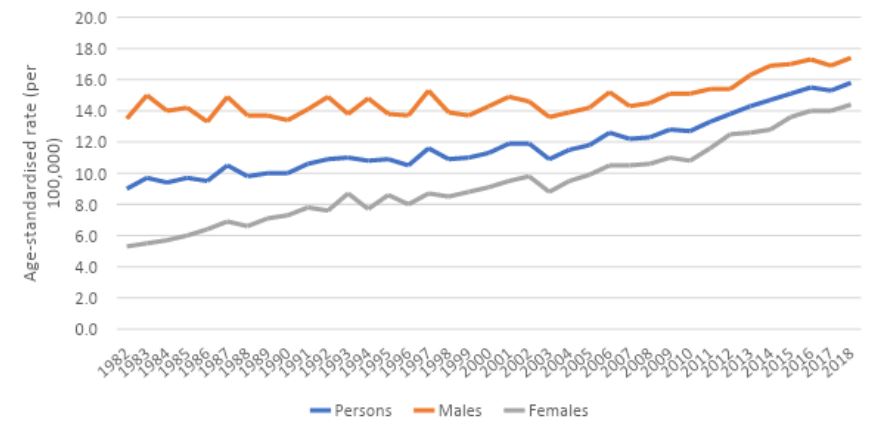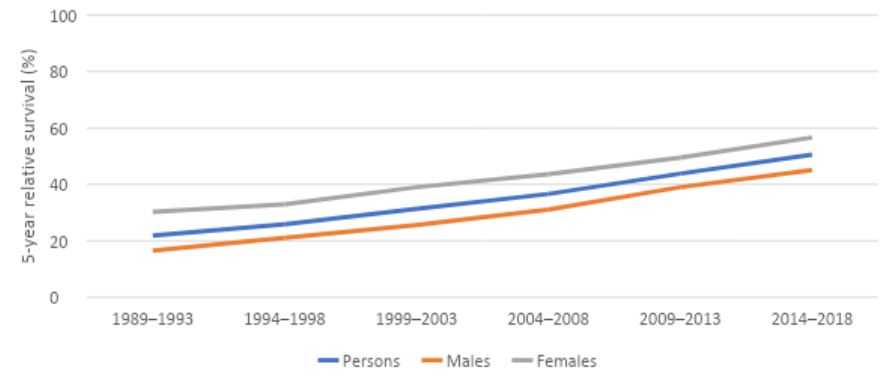The following material has been sourced from the Australian Institute of Health and Welfare
Neuroendocrine tumours incorporates ICD-10 cancer codes with associated histologies in 8013, 8040–8045, 8150–8156, 8158, 8240–8249, 8345–8347, 8680–8683, 8690–8693, 8700, 9091 for all topography codes or 8510 for topography C73.
Estimated number of new cases of neuroendocrine tumours diagnosed in 2022
5,437 =  2,846 males +
2,846 males +  2,591 females
2,591 females
Estimated % of all new cancer cases diagnosed in 2022
3.4%
Chance of surviving at least 5 years (2014–2018)
51%
People living with neuroendocrine tumours at the end of 2017 (diagnosed in the 5-year period 2013 to 2017)
11,656
New cases
In 2018, there were 4,508 new cases of neuroendocrine tumours diagnosed in Australia (2,398 males and 2,110 females). In 2022, it is estimated that 5,437 new cases of neuroendocrine tumours will be diagnosed in Australia (2,846 males and 2,591 females). In 2022, it is estimated that a person has a 1 in 55 (or 1.8%) risk of being diagnosed with neuroendocrine tumours by the age of 85 (1 in 52 or 1.9% for males and 1 in 58 or 1.7% for females).

Figure 1. Estimated cancer incidence in Australia, 2022
Notes
- Data sourced from AIHW Cancer Data in Australia 2022 web report and supplementary data tables
- More information about incidence rates for the most common cancers diagnosed can be found on the NCCI website in the ‘Cancer incidence’ section (https://ncci.canceraustralia.gov.au/diagnosis/cancer-incidence/cancer-incidence)
In 2018, the age-standardised incidence rate was 16 cases per 100,000 persons (17 for males and 14 for females). In 2022, it is estimated that the age-standardised incidence rate will be 17 cases per 100,000 persons (19 for males and 16 for females). The incidence rate for neuroendocrine tumours is expected to increase with age, highest for those aged 80–84 years.

Figure 2. Age-standardised incidence rates for neuroendocrine tumours, 1982 to 2018, by sex
Notes
- Data sourced from AIHW Cancer Data in Australia 2022 web report and supplementary data tables
- More information about incidence rates for neuroendocrine tumours over time, by age, sex, Indigenous status, remoteness, and socioeconomic status (SES) can be found on the NCCI website in the ‘Cancer incidence’ section (https://ncci.canceraustralia.gov.au/diagnosis/cancer-incidence/cancer-incidence)
The number of new cases of neuroendocrine tumours diagnosed increased from 1,173 (798 males and 375 females) in 1982 to 4,508 in 2018. Over the same period, the age-standardised incidence rate increased from 9.0 cases per 100,000 persons (14 for males and 5.3 for females) in 1982 to 16 cases per 100,000 in 2018.
Survival
In 2014–2018, individuals diagnosed with neuroendocrine tumours had a 51% chance (45% for males and 57% for females) of surviving for five years compared to their counterparts in the general Australian population. Between 1989–1993 and 2014–2018, five-year relative survival for neuroendocrine tumours improved from 22% to 51%.

Figure 3. 5-year relative survival for neuroendocrine tumours, 1989–1993 to 2014–2018, by sex
Notes
- Data sourced from AIHW Cancer Data in Australia 2022 web report and supplementary data tables
- More information about 5-year relative survival rates for neuroendocrine tumours over time, by age, sex, Indigenous status, remoteness, and socioeconomic status (SES) can be found on the NCCI website in the ‘Relative survival rate’ section (https://ncci.canceraustralia.gov.au/outcomes/relative-survival-rate/5-year-relative-survival-diagnosis)
Prevalence
At the end of 2017, there were 3,479 people living who had been diagnosed with neuroendocrine tumours that year, 11,656 people living who had been diagnosed with neuroendocrine tumours in the previous 5 years (from 2013 to 2017) and 24,285 people living who had been diagnosed with neuroendocrine tumours in the previous 36 years (from 1982 to 2017).
For more information, see Neuroendocrine tumours on the NCCI website
The National Cancer Control Indicators (NCCI) are a set of indicators across the continuum of cancer care, from Prevention and Screening through to Diagnosis, Treatment, Psychosocial care, Research and Outcomes. The NCCI website allows users to see visual representations of data on each indicator through interactive charts.




